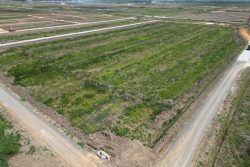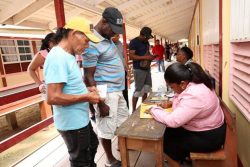Continued from last week
Hernias
Colloquially, all over the English speaking world, people describe hernias as ‘ruptures’. Please be advised that a hernia is a protrusion of an organ, or part of an organ, through an opening in a body wall. This ‘wall’ could be where the abdominal muscles meet; it could be the diaphragm; it could be in the area of the groin. The hernias are usually described according to the location: ‘abdominal’/’umbilical’ ‘diaphragmic’ or ‘inguinal’ (groin) or ‘scrotal.’
Hernias can also be defined by their origin. For example, if the ‘rupture’ has occurred because of a hit (a blunt force impacting on the skin or muscle), one can speak of an acquired hernia. On the other hand, the animal could be born with such a defect; we then speak of a congenitial hernia. This latter type has a hereditary basis, a genetic predisposition for delayed closure of the abdominal ring.
The two most common sites where hernias occur are the groin (inguinal) and around the navel (umbilical). When the bulge can be pushed back into the abdomen, the hernia is ‘reducible.’ When it cannot, the hernia is described as ‘incarcerated.’ An incarcerated hernia becomes ‘strangulated,’ if the blood supply to the tissues in the sac is pinched off. Accordingly, a painful hard swelling, usually in the area of the navel (umbilical) could be an incarcerated hernia – which is an emergency. You must seek immediate professional help for the animal.
Inguinal hernias
 This is not seen often in puppies. The bulge ap-pears in the groin (usually in a bitch); it may not be seen until after she is bred, or if she has become very old, in which case a pregnant or diseased uterus may be incarcerated in the swelling.
This is not seen often in puppies. The bulge ap-pears in the groin (usually in a bitch); it may not be seen until after she is bred, or if she has become very old, in which case a pregnant or diseased uterus may be incarcerated in the swelling.
Small inguinal hernias rarely occur in male puppies. If this happens, my advice is to watch the development closely, as many will close on their own without veterinary intervention. If not, have them repaired. Theoretically, at least, an inguinal hernia can lead to contents of the abdomen going through the groin into the scrotum. (This happens often in piglets).
Umbilical hernias
These are seen fairly frequently in puppies at about two weeks of age. An occasional case may be due to severing the umbilical cord too close to the abdominal wall, but most are due to an inherited tendency (genetic predisposition) for delayed closure of the umbilical ring.
Binding the abdominal wall with straps or with tape does little good. Most umbilical hernias in very young puppies get smaller and disappear by themselves by about six months. If you can push a finger through the ring, it will never close on its own; have it repaired. The operation is not serious; the pup usually goes home the same day. If a female is going to be spayed, repair could be postponed until that time.
Well, enough of this problem for today.
An important aside
There was recently a letter in the press about a horse being left to suffer on a roadway close to Georgetown. This correspondence evoked excited responses both local and foreign and among foreigners living in Guyana. The question was asked, disingenuously I think, who was responsible for this abomination. Well, the matter is not as straightforward as it may seem.
Let’s start with the ownership of the animal. Was the animal branded? If not, how does one establish ownership? Rushing to euthanize the animal can have some serious consequences, as the GSPCA can recall from bitter experience. In a similar situation, some years ago, the owner not only argued that his horse was under veterinary care and supervision, but a vet actually came forward and confirmed the owner’s position. Only when we confronted the vet with the graphic pictures of the irreparable damage (which he was supposedly going to cure) that the issue was brought to closure. The GSPCA has had to deal with serious repercussions when emotional, knee-jerk reactions by the Society’s members and the public had forced them to take action which turned out to be questionable, even illegal. The GSPCA has now specific rules which the Society must follow, if it wishes to be taken seriously, and not risk legal sequelae.
The law requires that a qualified/registered vet certifies the need for euthanasia, and that there should be consent from the owner.
Then there are the other actors in similar dramas:
The Regional and Neighbourhood Democratic Council/ Mayor and City Council
The Ministry of Home Affairs
The City Constabulary/Rural Constables
The Judiciary
The National Parks Commission/ Zoological Gardens
The Guyana Veterinary Association
The Guyana Livestock Development Authority
The Ministry of Agriculture
The GSPCA
One could write a thesis on this issue, and on the involvement, or rather non-involvement, of these above-mentioned entities.
Further, how was this animal euthanized? By a bullet/bolt in the skull in the presence of all those who gathered to witness the spectacle – with all its concomitant indelible psychological trauma? Who decided that the horse had ‘Kentucky disease’? What is Kentucky disease?
Let it be clear:
1) Most veterinarians employed by the state fall under the rubric of the Guyana Livestock Development Authority. (GLDA).
2) The GLDA has a 24/7 unit to deal with matters such as those delineated in the letter.
3) The GLDA veterinarians have vehicles, medication and other materiél at their disposal.
4) The Guyana Veterinary Association (GVA) has scores of members.
5) The GVA/GLDA must have a roster relative to who is on emergency duty during weekends and holidays.
6) Hotline (emergency) phone numbers could be published.
7) The GSPCA relies on the GLDA for a staff veterinarian.
8) The GSPCA does not have a vet on its payroll; nor can it, since vets are substantively indebted/associated with the GLDA or some other organization and therefore cannot unilaterally join the Animal Clinic and Shelter.
9) The GSPCA should pursue the possibility of recruiting a (retired?) veterinary surgeon to work full time at its Animal Clinic and Shelter. Donations towards the vet’s salary could come from all those caring persons who do not wish animals in Guyana to suffer.
I’ll stop now. There is so much more to be said about the issue of the dying horse.
Please implement disease preventative measures (vaccinations, routine dewormings, monthly anti-heartworm medication, etc) and adopt-a-pet from the GSPCA’s Animal Clinic and Shelter at Robb Street and Orange Walk, if you have the wherewithal to care well for the animals. Do not stray your unwanted pets, take them to the GSPCA’s Clinic and Shelter instead. If you do not wish your pet to have puppies or kittens, you may exploit the GSPCA’s free spay and neutering programme. If you see anyone being cruel to an animal, or if you need any technical information, please get in touch with the Clinic and Shelter by calling 226-4237.







